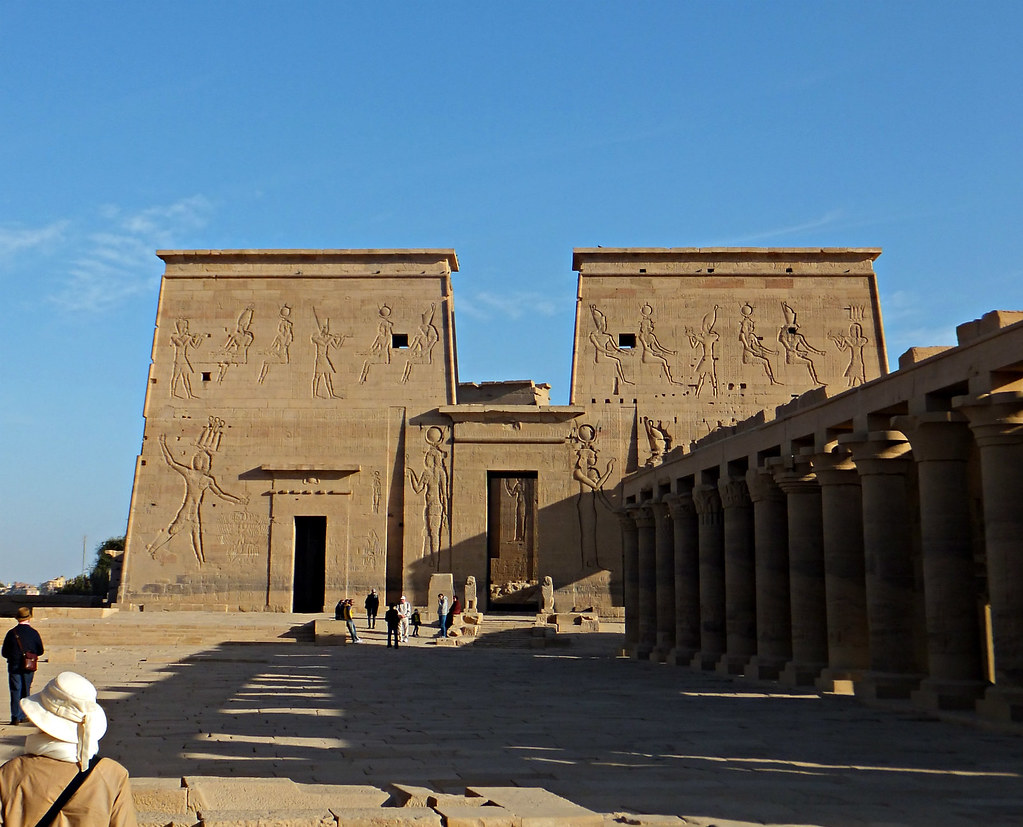

A piece of granite along the Eastern Tower called a stele is carved of Ptolemy VI Philometor standing with Cleopatra II and Isis and Horus. Also depicted is the king offering flowers to Nephthys and Horus, and another of the king pouring water and presenting incense on an altar while in the presence of Horus, Isis and Osiris. Second Pylon: The Western Tower depicts Ptolemy XII offering animals and incense to various gods including Hathor and Horus. Numerous inscriptions inform us that Greek and Roman pilgrims. The worship of Isis attained great importance during the Graeco-Roman period when her influence extended to Grace itself and to Rome. It was begun by Ptolemy II, Philadelphus and completed by Ptolemy III ,Euergetes. Here, the king conducted rituals to validate his descendancy from Horus. The great Temple of Isis is the principal building on the island. There is also a relief of Isis carrying a newborn Horus in her arms while being protected by Wadjet, Nekhbet, Amun-Ra and Thoth. Where to find the Temple of Philae The Temple is now located on the Agilika Island in Aswan, near the Aswan Dam and The High Dam. In 1960, UNESCO began a 20-year rescue project that lowered the inundation and saw around 50,000 stones moved to its current site on nearby Agilkia Island where you can still visit and explore the temple to this day.© Jorge Láscar - Side of the First Pylon and the forecourt of the templeīirth House: A common feature in Ptolemaic temples, the Birth House in the Temple of Isis depicts Horus as a hawk wearing a double crown standing among papyrus. Isis is a goddess that became quite popular in ancient Egypt and other sections of the Roman Empire, the Philae Temple was the center of the worship of Isis and a common Pilgrimage site of ancient Egypt. By the 1960s, a third of Philae’s ancient structures were permanently submerged, and underwater damage stripped the site of its vegetation and colorful reliefs. Following the rise of Christianity, the temple was officially closed in 537 AD and rededicated to the worship of Saint Stephen.Īt the very beginning of the 1900s, the temple complex was flooded due to the construction of the Aswan Low Dam. A western gate was added to the complex by the Romans in between 117 AD and 138 AD. While remaining a holy site, the island itself also functioned as part a major trade route and was often visited by merchants and those vacationing on pilgrimage.Īlthough shrines dedicated to the worship of Isis were built earlier on the island, major construction of the temple was carried out by Ptolemy II and later his successor Ptolemy III, whose reigns lasted from 285-221 BC. Later Roman leaders Augustus and Tiberius continued to decorate the site from 27-37 BC, but their works were never completed. It was said that fish never swam close and fowl refused to fly above the sacred land. Since only the religiously devout were allowed to live there, it was referred to as “the Unapproachable” by ancient Romans who later conquered and occupied Egypt. The original island of Philae was considered sacred due it being one of the many legendary burial places of Osiris, a god of fertility, death and rebirth.

Its walls portray scenes of the resurrection of her husband Osiris, his later mummification, and the birthing of their son Horus, one of the most prominent gods in the ancient Egyptian pantheon. The temple was the built by followers of the cult of Isis, a goddess often referred to as the mother of the gods. The Temple of Isis originally sat on the island of Philae in the middle of the Nile River in the southern part of the ancient Egyptian empire.


 0 kommentar(er)
0 kommentar(er)
